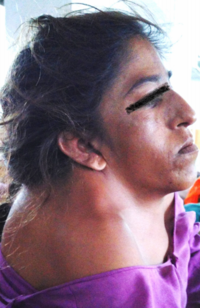
Photo from wikipedia
Background Recently, there have been some reports on surgical treatment for Klippel–Feil syndrome, but the prevalence and risk factors of surgery have not been well evaluated. This study sought to… Click to show full abstract
Background Recently, there have been some reports on surgical treatment for Klippel–Feil syndrome, but the prevalence and risk factors of surgery have not been well evaluated. This study sought to find the prevalence and potential risk factors of surgical treatment. Methods A retrospective radiographic review of 718 Klippel–Feil syndrome patients seen at Peking University Third Hospital from January 2010 to October 2017 was performed. Parameters included age, gender, deformity, cervical instability, Samartzis classification, and surgical treatment. Based on the surgical treatment they received, patients were divided into a surgery group and a non-surgery group. Prevalence and possible risk factors of surgical treatment were assessed. Results A total of 718 Klippel–Feil syndrome patients, including 327 men and 391 women, with an average age of 46.8 years were enrolled. According to the Samartzis classification scheme, 621 cases (86.5%) were classified as type I, 48 cases (6.7%) were classified as type II, and 49 cases (6.8%) were classified as type III, respectively. The most commonly fused segments were C2–3 (54.9%) and C5–6 (9.3%). Of all 718 patients, 133 (18.5%) patients underwent surgical treatment, mainly via the posterior approach (69.9%). The clinical factors included age, gender, deformity, instability, and Samartzis classification. Men were more likely to require surgical treatment (p < 0.001). Patients with instability (p < 0.001) or patients with deformity (p = 0.004) were also more likely to undergo surgery. All three of these variables were included in the binary regression analysis. Finally, gender (p < 0.001) and unstable joints (p < 0.001) were identified to be independently associated with surgical treatment. Gender was the most important risk factor with men being 2.39 times more likely to have surgical treatment, while patients with instability were 2.31 times more likely to receive surgery. Conclusion The prevalence of patients with Klippel–Feil syndrome requiring surgery was 18.5%, with the majority undergoing posterior cervical surgery. Gender and instability were indemnified as independent risk factors leading to surgical treatment.
Journal Title: Frontiers in Surgery
Year Published: 2022
Link to full text (if available)
Share on Social Media: Sign Up to like & get
recommendations!